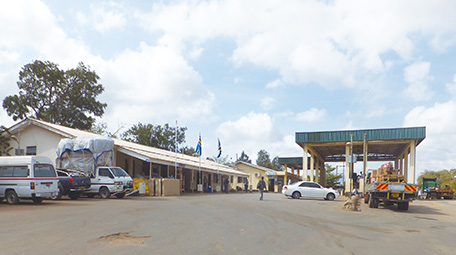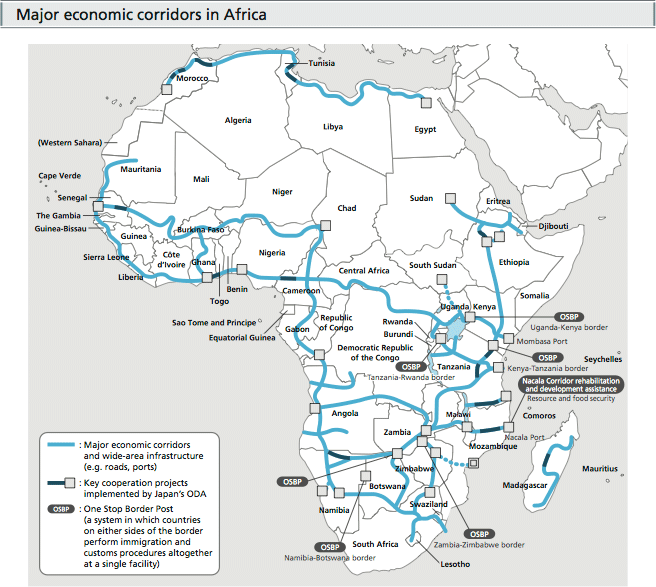Japan's Official Development Assistance White Paper 2013
Section 2 African Growth and What is Desired of ODA
What are on the future development agenda for Sub-Saharan Africa, which has begun to show remarkable growth after years of stagnation? They are: the proper development and management of natural resources that constitute the foundation of growth; the promotion and diversification of domestic industries such as agriculture and manufacturing; and the promotion of sustainable economic growth by creating domestic employment opportunities, among other methods. ODA’s importance as “investment in the future” is increasing as Sub-Saharan Africa experiences continuous strong economic growth and inflows of private investment. To support Africa’s self-sustaining and sustainable growth, Japan will utilize ODA and other schemes as a catalyst to contribute to further attracting private investment, including Japanese investment, all the while respecting African ownership and conforming with the tradition of international partnership, which Japan has been continuously advocating since the commencement of the TICAD process.
Among the different sectors, Africa attaches the most importance to infrastructure development in the context of “investment in the future.” One of the significant impediments to African growth is the cost of transboundary transport. Having numerous landlocked countries, Africa has huge needs for transboundary transport across national borders. However, this entails extensive costs. Unless infrastructures, including transportation routes, are developed, Africa’s abundant natural resources will not be utilized. Unhindered transboundary transport is expected to reduce transportation costs, promote trade and industries, and by extension, encourage social and economic integration in the region. This in turn is expected to lead to economic growth.
To resolve these problems, the African Union (AU) Summit in 2012 adopted the “Programme for Infrastructure Development in Africa (PIDA),” a continental agenda for infrastructure development that should be undertaken by 2040. Japan supports the creation of a region-wide economic zone by promoting infrastructure development intertwined with regional development. Taking into account the above perspective, Japan’s assistance of this type includes cooperation in soft aspects, such as eliminating bottlenecks to international corridors (e.g., border customs clearance facilities and bridge construction) and strengthening the capacities of customs officers, and provides comprehensive supports for improving the distribution environment in the region. For example, Japan, through co-financing with the African Development Bank (AfDB), supported the improvement of the international trunk road between Arusha in Tanzania and Athi River in Kenya and that of the main section of the only route linking the capital cities of Kenya and Tanzania in the East African Community (EAC). Japan was in charge of improving the section on the Tanzania side (between Arusha and Namanga), and through technical cooperation, supports the establishment of One Stop Border Posts* on the Namanga border. Infrastructure development, in both hard and soft aspects, not only facilitates the movement of people and goods from production sites to consumption sites and boosts inter-state economic and trade activities, but also has the effect of turning the entire region into an attractive market for private companies.
Meanwhile, many of the African population are still in poverty (in Sub-Saharan Africa, many people live on less than $1.25 a day and the poverty rate is high; see the graph below). Out of all regions, Sub-Saharan Africa has by far the worst record in terms of the number of deaths among children under age five, the number of maternal deaths, and the number of deaths due to HIV/AIDS and malaria. Furthermore, access to safe water in Sub-Saharan Africa is still far from adequate. From a human security perspective, ODA remains indispensable to the efforts in the MDG fields, and international assistance must be continued.

In addition to these efforts, improving the quality of primary and secondary education contributes to establishing a foundation for training human resources for business and industry in the mid- to long-term, which is necessary for Africa to realize self-sustaining and sustainable economic growth, similar to infrastructure development. Development of human resources for business and industry is essential for attracting private investment, and African expectations in this area run high. Africa conventionally has had an absolute shortage of human resources who had primary and secondary education, and their professional skills were often not of a level to be hired by foreign companies that advanced into Africa. This made it difficult for companies to secure local human resources. As a result, companies at their own expense conducted trainings for local people or brought in workers from abroad. Increasing the professional skills of local human resources therefore not merely enhances the capabilities of local people, but also contributes to reducing human resource costs for companies at the hiring end, in turn making Africa a more attractive investment destination. Through ODA, Japan will implement assistance and human resource development towards achieving the MDGs and support African growth by promoting trade and investment.

One Stop Border Post facility in Namanga on the Kenya-Tanzania border (Photo: JICA)

- *One Stop Border Post (OSBP)
- One of the customs clearance approaches which has been drawing attention amidst the movement to create common customs procedures and increase the efficiency of customs clearance. While normally, export and import procedures are required at both sides of the border, these procedures are performed at one time under OSBP. This in turn shortens the retention time of supplies that cross the border and promotes distribution.
